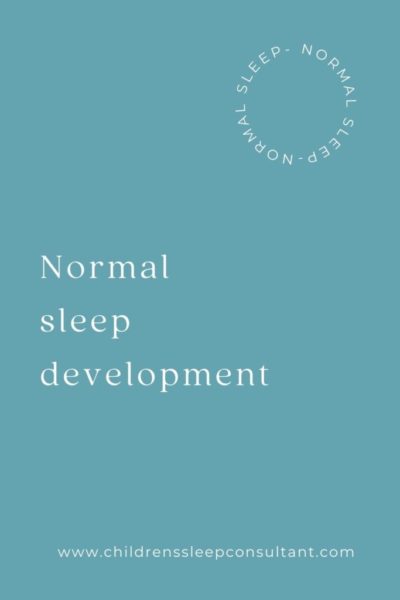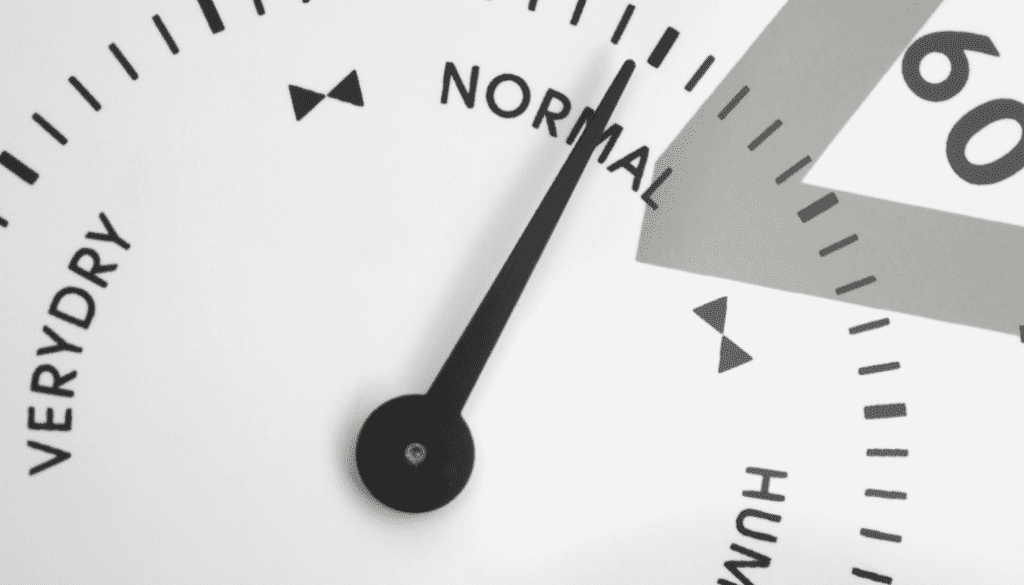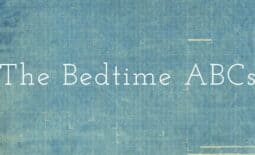Normal Sleep Development
There is so much BS out there about what is normal when it comes to sleep development and what’s normal.
So, for this post, we’re taking a deep dive into normal sleep development.

NEWBORN 0- 3 MONTHS OLD
Within the first 3 months of life, children sleep for short periods. They’re sleeping for shorter periods. They won’t get into a deep sleep and not sleep like we do, getting long deep stretches of sleep. Everything is a nap.
Newborns don’t produce high melatonin levels, a hormone we produce that induces sleep. The low level they create doesn’t impact their sleep at all. Newborns don’t need to sleep in the dark they can sleep wherever it is safe to do so.
You may have noticed that newborns need movement to get to sleep. Why is this? When they were inside the womb, there was a lot of movement as you were going about your day, and that movement would then lull them to sleep. Since they’ve grown accustomed to it, mimicking that movement will help your newborn get to sleep. You can’t create any bad habits with a newborn, don’t be afraid to help your child sleep with movement. Rocking, swaying, walking, dancing, etc., are all great ways to help your child relax. You may find that babywearing is helpful at this age.
Of course, we can’t forget the obvious way to send them to sleep: feeding. And the reason why this is an effective way to lay them down is that it is hard work for a baby to feed; when your baby feeds, they release the hormone oxytocin, this hormone is very relaxing for your child, and they may not be able to stay awake.
Night sleep begins to develop at around 6 weeks old, and your newborn may begin to sleep for some longer stretches at night. Bedtime is usually quite late, but it will gradually get earlier as your child gets older.
3 – 12 MONTHS OLD
As your child develops, so does their sleep. There is a big shift with sleep that happens around 12 weeks from your child’s due date.
Your child’s sleep will shift from newborn sleep cycles to the same sleep cycles you and I go through, though they are shorter. This means your child is now getting into the deepest sleep, and they are dreaming.
Night sleep continues to develop; you may notice your child gets a longer stretch of sleep at the beginning of the night. Their bedtime may still be quite late, but it will naturally get earlier over the next few weeks/months.
Hunger is still going to dictate wake ups through the night. Though some children in this age group are sleeping through the night, the majority are not. If your child is waking hungry, the best thing to do is feed them!
When your child gets into a darkened space, they will produce higher levels of melatonin. This hormone induces sleep and is something we want your child to produce.
Different areas of the brain now manage day naps and night sleep. Your child may be getting some longer stretches at night, but naps are likely to become more of a challenge. Lots of children can nap longer with help. Maybe they’ll take a longer nap if you go for a walk with them in the stroller or the carrier. This happens due to the movement lulling them back into a deeper sleep at the end of their sleep cycle. You may notice them beginning to wake. They may start moving around a little or making some noises. The movement of you walking, you may also begin to pat their back a little and shush, will help them back into a deeper sleep, and they have connected sleep cycles.
Naps begin to develop sometime between 4 and 6 months of age. They develop individually. The first nap of the day is the first to develop, then the second, and then the third. Until they have developed, you may find naps to be a challenge. Don’t worry; this is quite normal.
A lot is happening developmentally at 9 months old; as they start to move around, they are likely to have some separation anxiety. There is also a lot developing in their brain. These developmental changes will cause a big sleep regression. This regression can last a while. A couple of months is not unheard of! Sorry.
We will continue with the 2 naps a day until your child is ready for one nap; this usually happens sometime between 12 and 18 months of age.
12 – 24 MONTHS OLD
Your child will be ready to drop to one nap sometime between 12 and 18 months of age; the average age is 15 months old. Some signs to look out for are; struggling to fall asleep for either nap, especially the second nap of the day, struggling to fall asleep at the beginning of the night, or beginning to wake earlier in the morning.
It will take your child between 20 and 30 minutes to fall asleep at the beginning of the night.
When your child reaches 12-months-old, you can introduce a pillow and blankets to your child’s bed. There is no rush; some people suggest waiting until nearer to 18 months to introduce a pillow. If their mattress has a toddler side, you can flip that now.
Your child will need between 10 and 12 hours of sleep at night and around 2 ½ hours sleep during the day. Though your child has a specific amount of sleep, they need every 24 hours. Don’t judge if your child needs more sleep by looking at how tired they are before falling asleep for their nap(s) or at the beginning of the night. That’s when we want them to be tired. Don’t look at how they are when they wake up; lots of us are slow to get going and a little grumpy when we wake. Take a look at how your child seems at the mid-point between waking up and falling asleep. Do they seem tired and irritable (and not hungry)? If so, they may need some more sleep every 24 hours; if not, they may be getting enough. That doesn’t mean we can’t improve sleep and help your child fall asleep easily and sleep easier for longer stretches.
Around 50% of children in this age range need help to fall asleep at the beginning of the night, often with a parent remaining with the child.
Between 30 and 35% of children within this age range continue to wake during the night. The frequency of night awakenings decreased significantly towards 18 months of age.
We will often see a nap strike around 18 months of age, where your child may refuse to nap and insist they no longer need a nap. This is false; they do still need a nap, I promise you. Don’t worry if they don’t nap but do insist on a quiet time. I wouldn’t call it a quiet time though; toddlers and quiet do not go well together, and they may protest a quiet time more than they would have protested a nap! A siesta is a good name. If they have their siesta each day, when they are ready to start napping again, they are in the right place to do so.
2 – 3 YEARS OLD
Sleep disturbances aren’t just for babies; toddlers can have their fair share of sleep issues.
Having a night or two a week where your child wakes and needs help is very common; over 70% do so.
Toddlers are expert procrastinators! They all get to an age where they have the knowledge and understanding to delay bedtime. This can be very frustrating for parents; you are done at the end of the day and REALLY want your child to get to bed. Instead, they have other ideas! They may repeatedly get out of bed, fight to get into bed, talk for a long time, delay, delay, delay. It’s not uncommon for toddlers to take an hour to fall asleep.
Not only is your child a procrastinator, but they will enjoy pushing the limits. You may find your child begins to push against their sleep routines (as well as getting into the car, the bath, anywhere, really!). You ask them to do anything, and they’ll reply ‘no,’ then when you try to help them with anything, they want to do it themselves. Oh, my, these toddlers can be frustrating.
Your toddler will need between 12 and 14 hours every 24 hours, and that does include their nap.
3 YEARS +
Now you can reason with your child, and their language has taken off, life gets a little easier, especially with sleep.
Your child may continue to procrastinate and push back against your routines slightly, but they should be manageable.
Your child will drop their nap sometime between 3 and 5 years old. It’s a sad day when we say goodbye to the nap, but when your night sleep improves (if their nap was hurting the night sleep), it’s all worth it. Some signs your child is ready to drop their nap are – taking an incredibly long time to fall asleep for their nap, which in turn can make bedtime at night much later; waking earlier in the morning is the biggest sign your child is ready to drop their nap.
When your child’s imagination begins to take off, we often see that they may have some bad dreams and fear falling asleep. These are very common. Give your child the support they need and make sure they aren’t watching anything too scary (no Scooby Do, sorry!). A nightlight in the room can be very helpful if your child is struggling with the dark bedroom.
You can try and explain what dreams are, that they’re not real but do feel like real stories in our brains.
Your child will need between 12 and 14 hours of sleep per 24 hours.

Want more help gently sleep training?
I’ve got you covered. Join the membership to access…

Gentle sleep training support
 Over 40 masterclasses, helping you with sleep changes and issues.
Over 40 masterclasses, helping you with sleep changes and issues.

Get all your questions answered in a live weekly Q & A.

+ so much more – 1 on 1 opportunities, bedtime meditations, downloads, all the help you could need.






